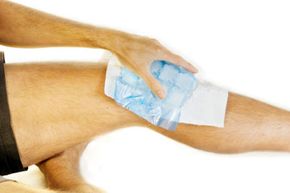One of the most common questions I get is whether ice or heat is best for pain and injuries. Well, it depends. Both can be beneficial at different times. The following are some guidelines on when to utilize each.
The safest choice for treatment of injuries is ice. This method is best for injuries or pain that is less than 24 hours old, or any injury that continues to produce swelling. Ice decreases pain and provides vasoconstriction (closing of small blood vessels). This helps limit the amount of swelling that occurs immediately after the injury. It also has a calming effect on nerves, which can decrease pain. Ice or cold packs should never be put directly on the skin due to the risk of frostbite. In fact, cold packs can be even colder than natural ice. Neither ice nor cold packs should be used for longer than 30 minutes. To get added results for treatment of swelling, elevate the area being iced.
Advertisement
Ice Tips:
- Rub the ice cube over the affected area until it melts completely.
- Soak a thin washcloth in cold water. Wring it out and place over the affected area. Place a bag of frozen vegetables or bagged ice on top. If you want, use an Ace wrap to hold it in place.
- For hands or feet, soak in a bucket or bowl of icy water for 10-15 minutes.
Heat promotes muscle relaxation, and is best used on postural muscles like those along the lower back, mid-back and neck. Muscle soreness and spasms are the most common symptoms treated with heat. This method can also help with osteoarthritis to increase range of motion and, therefore, decrease pain. Heat should also be applied for only 30-minute intervals.
Know that, when heat it is applied over an area of acute injury, active inflammation or swelling can get worse, as heat causes vasodilatation (opening of the small blood vessels), the opposite of ice. Another danger of using a heating pad is burning the skin. Commonly, a person will fall asleep on the heating pad or simply leave it on too long.
Moist heat is the most effective form. Physical therapists use a machine called a hydrocollator that keeps the hot pack in 160 degree water. Several layers of towels are used between the hot pack and the skin.
Heat Tips:
- Use an electric heating pad.
- Apply for no more than 30 minutes.
- Place a cloth layer between the heating pad and the skin. The first few times the heating pad is used, check the skin every 5 minutes to make sure there is no burning.
- The setting on the heating device should be at the minimum level where you still feel heat. A higher setting is not better, just more likely to burn.
I’ve heard you should alternate ice and heat. Is there any truth to that?Contrast baths (alternating heat and ice) are popular with athletes who need to reduce swelling in the extremities very quickly. This method promotes the opening and closing of blood vessels to pump swelling out of the area. It’s done by having two buckets, one with warm (not hot) water and one with cold (not icy) water, in which the extremity is placed for a total of 45 minutes, moving it directly from one bath to another every 5-10 minutes. This technique is not used to reduce pain.
How long should I wait between 30-minute ice or heat sessions?With any heating or icing, if a repeat session is needed, wait until the skin is completely back to normal in appearance and temperature. This usually takes between 30 and 60 minutes, depending on the individual’s response. Never reapply heat or ice before the skin has completely recovered.
Advertisement

